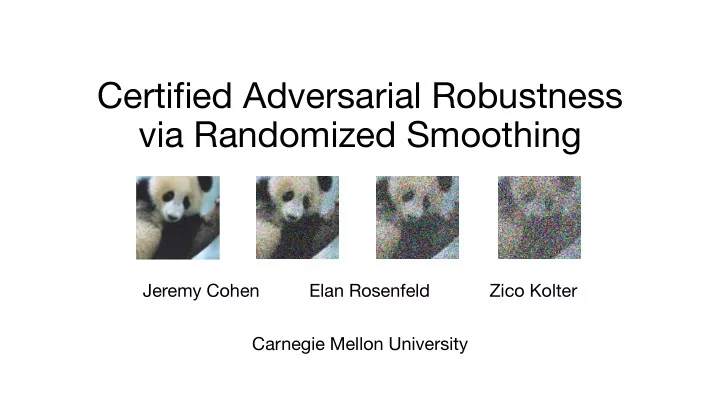

Certified Adversarial Robustness via Randomized Smoothing Jeremy Cohen Elan Rosenfeld Zico Kolter Carnegie Mellon University
Introduction We study a certified adversarial defense in ℓ " norm which scales to ImageNet Background: • Many adversarial defenses have been “broken” • A certified defense (in ℓ " norm) is a classifier which returns both a prediction and a certificate that the prediction is constant within an ℓ " around the input Certify that every prediction # inside this ball will be “panda.” • Most certified defenses don’t scale to networks of realistic size
Prior work on randomized smoothing • Randomized smoothing was proposed as a certified defense by [1] • The analysis was improved upon by [2] • Our main contribution is the tight analysis of this algorithm [1] M. Lecuyer, V. Atlidakis, R. Geambasu, D. Hsu, and S. Jana. “Certified Robustness to Adversarial Examples with Differential Privacy,” IEEE S&P 2019. [2] B. Li, C. Chen, W. Wang, and L. Carin. “Second-Order Adversarial Attack and Certifiable Robustness,” arXiv 2018.
Randomized smoothing • First, train a neural net ! (the “base classifier”) with Gaussian data augmentation: corrupted by Gaussian noise clean image • Then, smooth ! into a new classifier " (the “smoothed classifier”), defined as follows:
Randomized smoothing ( ( ! ) = the most probable prediction by " of random Gaussian corruptions of ! Example: consider the input ! = Suppose that when " classifies # !, % & ' , is returned with probability 0.80 is returned with probability 0.15 is returned with probability 0.05 Then ( ! =
Randomized smoothing ( ( ! ) = the most probable prediction by " of random Gaussian corruptions of ! Example: consider the input ! = Suppose that when " classifies # !, % & ' , is returned with probability 0.80 is returned with probability 0.15 is returned with probability 0.05 ! Then ( ! =
Randomized smoothing 0.80 ( ( ! ) = the most probable prediction by " of 0.15 0.05 random Gaussian corruptions of ! Example: consider the input ! = Suppose that when " classifies # !, % & ' , is returned with probability 0.80 is returned with probability 0.15 is returned with probability 0.05 ! Then ( ! =
Class probabilities vary slowly 0.80 If we shift this Gaussian, the probabilities of 0.15 0.05 each class can’t change by too much. Therefore, if we know the class probabilities at the input ! , we can certify that for sufficiently small perturbations of ! , the probability will remain higher than the probability. !
Robustness guarantee (main result) • Let ! " be the probability of the top class ( ) • Let ! # be the probability of the runner-up class ( ). ! " • Then $ provably returns the top class within an ℓ & ball around ' of radius 0.80 & (Φ -. ! " − Φ -. ! # ) ( = * ! # 0.15 where Φ -. is the inverse standard Gaussian CDF 0.05 .
There’s one catch When ! is a neural network, it’s not possible to exactly • - evaluate the smoothed classifier - certify the robustness of the smoothed classifier • However, by sampling the prediction of ! under Gaussian noise, you can obtain answers guaranteed to be correct with arbitrarily high probability
ImageNet performance ! = 0.50 ! = 1.00 ! = 0.25 ! = 0.00 1.0 σ = 0.25 σ = 0.50 0.8 certified accuracy σ = 1.00 undefended 0.6 0.4 0.2 0.0 0.0 0.5 1.0 1.5 2.0 2.5 3.0 3.5 4.0 radius Note: the certified radii are much smaller than this noise.
Thanks for listening! Poster #64, 6:30 PM – 9:00 PM tonight Code and trained models: http://github.com/locuslab/smoothing
Recommend
More recommend